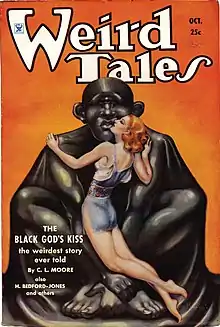Shambleau
"Shambleau" is a short story by American science fiction and fantasy writer C. L. Moore. Though it was her first professional sale, it is her most famous story. It first appeared in the November 1933 issue of Weird Tales and has been reprinted numerous times. It features one of Moore's best-known heroes, Northwest Smith, a gun-toting spacefarer, and is a retelling of the Medusa myth; it looks at themes of sexuality and addiction.

Plot
On Mars, tough smuggler Northwest Smith encounters a young woman being chased by a mob. Instinctively, he decides to protect her. The crowd identifies her as "Shambleau", but Smith does not recognize the name. He is surprised when the mob disperses without violence when he claims her as his own. To his puzzlement, he senses disgust, not hatred, aimed at him.
When Smith takes a closer look at the woman, he realizes that she is not human, though she is attractive. Feeling some responsibility for her, he allows her to shelter in his room, while he conducts his illegal business.
Smith eventually discovers firsthand that a Shambleau feeds on the life-force of others using the extensible, worm-like appendages it has instead of hair, while addicting its short-lived victims with pure ecstasy. Fortunately for Smith, his Venusian partner Yarol comes looking for him and finds him before it is too late. Unlike Smith, he knows what the creature is. Though he himself is drawn to the Shambleau, he manages to avert his gaze; then, using the Shambleau's reflection in a mirror, Yarol is able to shoot and kill it. Later, he speculates that the story of Perseus and Medusa had its origins in the activities of a Shambleau on ancient Earth.
Publication history
- Weird Tales. Popular Fiction Population Co. November 1933.
- Avon Fantasy Reader #7 (Online text ed.). 1948. pp. 3–28.
- Shambleau and Others. Gnome Press. 1953.
- The Best of C.L. Moore (paperback ed.). USA: Nelson Doubleday, Inc. 1975. ISBN 9780345247520.
- The Penguin Book of Vampire Stories (paperback ed.). USA: Penguin Books. 1987. pp. 255–281. ISBN 978-0140124453.
- The Wesleyan Anthology of Science Fiction (paperback ed.). USA: Wesleyan University Press. 2010. pp. 110–135. ISBN 978-0-8195-6954-7.
Response
Several commentators refer to the lynching scene that starts the story. Thomas F. Bertonneau remarks that "Moore's protagonist gets into trouble by rescuing what appears to be a young woman from a Martian lynch-mob: his sense of the dignity of the persecuted victim leads him to put himself in danger by opposing the witch-hunters. (Later, Smith has to be rescued from the young woman, who turns out to be a monster in disguise; victimhood can be a disguise.)"[1]
Bernard Fields adds that, "The disturbing undercurrent is that the lynch mob turns out to have been right in wanting to kill the 'sweetly made girl'. Smith was wrong in his chivalrous impulse to save her, and the mob was right to despise him for it."
See also
- 1933 in science fiction
- Shambleau / read by the author, C. L. Moore
- Eel Girl (2008), a horror science fiction short film
- Harpya (1979), a Belgian short animated film
- "Jenifer" (Masters of Horror episode)
- Tomie, a Japanese horror manga series
References
- Thomas F. Bertonneau, "Monstrous Theologies: The Theme of Anti-Sacrifice in the Sci-Fi Pulps" in Anthropoetics 6, no. 1 (Spring/Summer 2000)